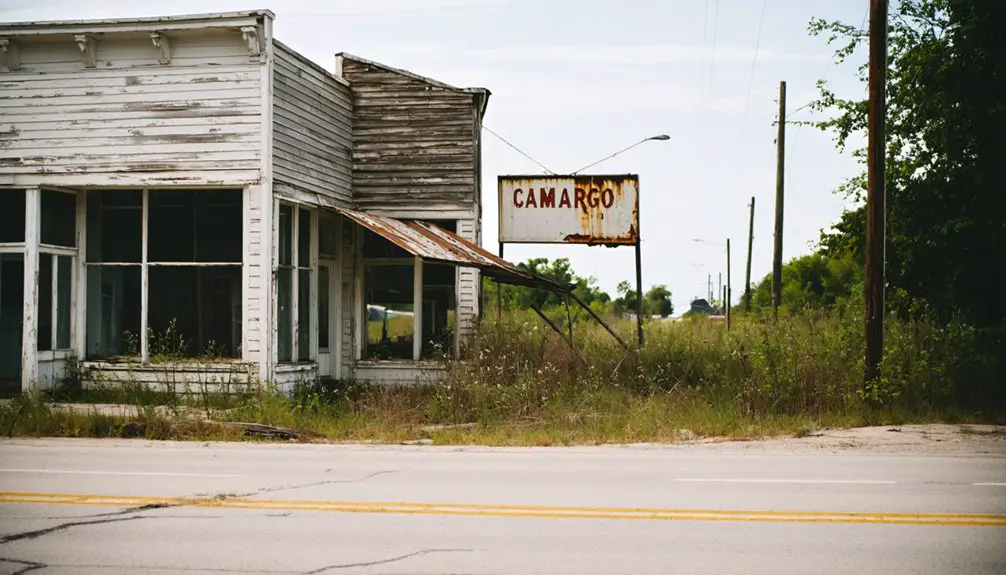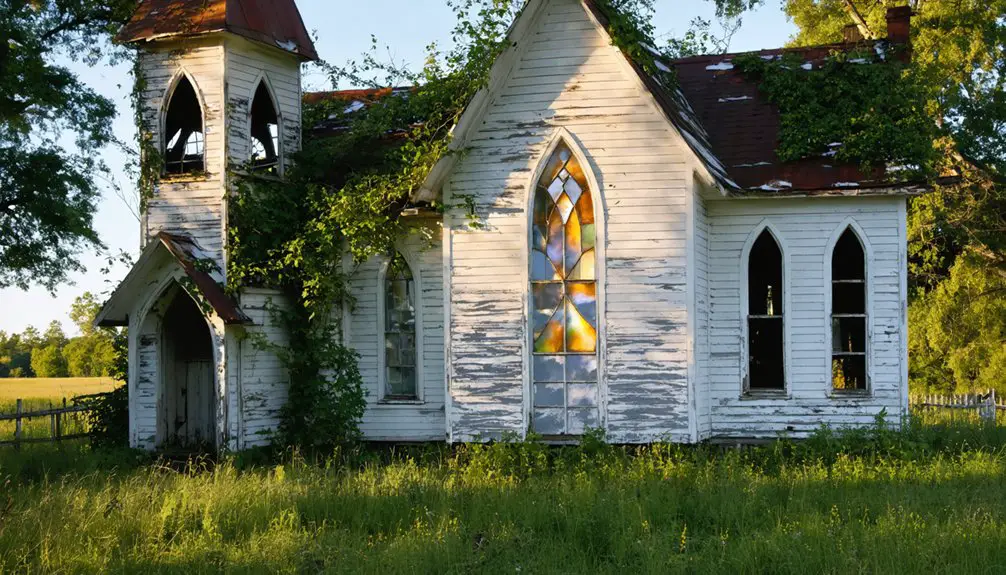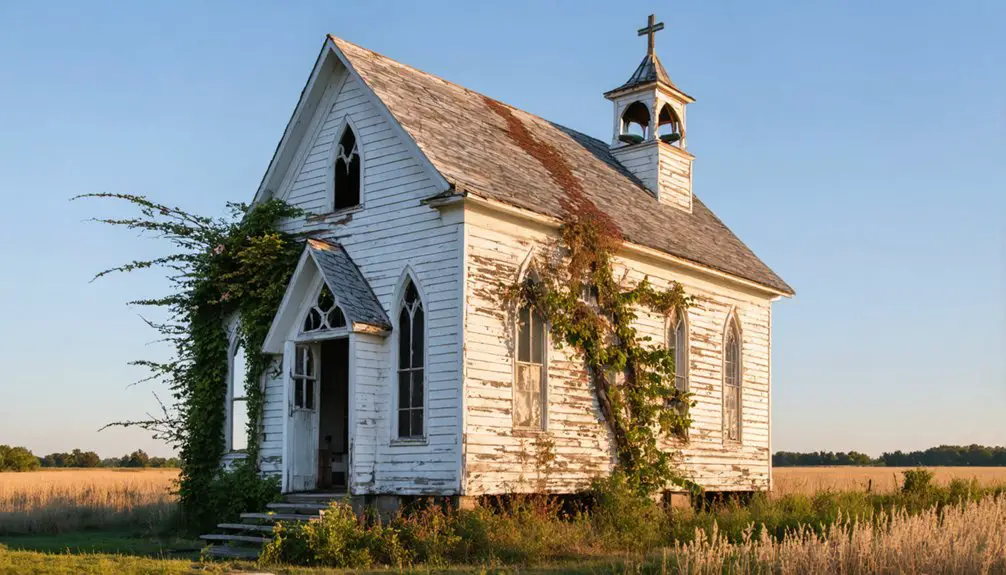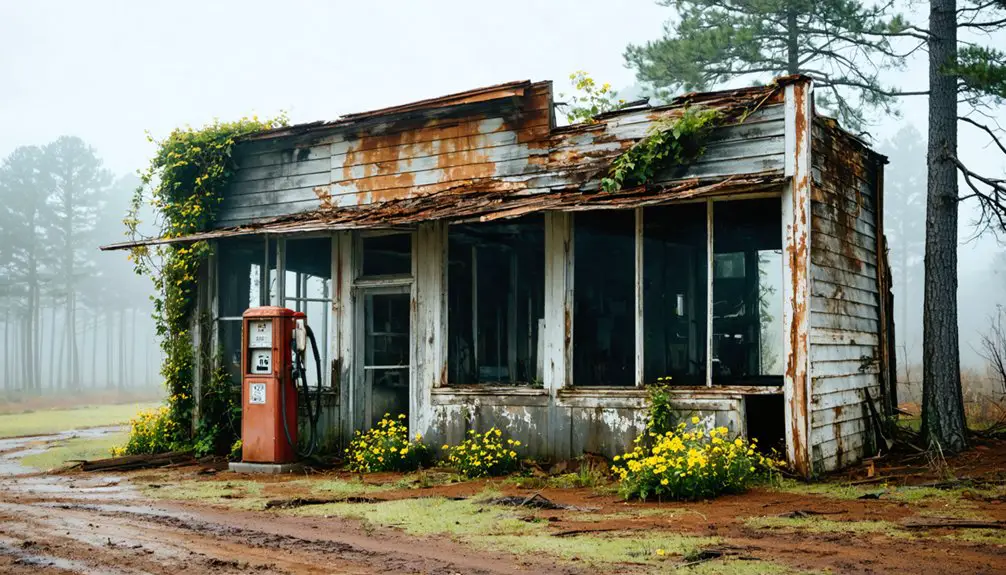You’ll find the remnants of Camargo, Mississippi nestled along Old Town Creek, where a once-bustling river port town stood proudly from 1847. Founded by Mexican-American War veterans, this strategic hub shipped thousands of cotton bales annually and featured thirty-five thriving stores. Today, weathered tombstones and decaying buildings with ornate wrought iron entryways tell tales of its glory days, before the railroads sealed its fate in the 1870s. Each crumbling brick holds secrets of frontier life waiting to be uncovered.
Key Takeaways
- Founded in 1847 as a Mississippi River port town, Camargo thrived on steamboat commerce and cotton trade until railroad development.
- The town featured 35 stores, a Masonic Lodge, and served thousands of residents during its peak as a river commerce hub.
- Camargo’s decline began when railroads redirected trade routes in the late 1840s, leading to economic challenges and population loss.
- Physical remnants include a three-acre cemetery with 200 tombstones, decaying buildings with ornate details, and old road infrastructure.
- The ghost town’s location along Old Town Creek preserves evidence of Mississippi frontier life and Civil War history.
The Birth of a River Port Town
In 1847, a strategic vision for a bustling river port materialized along Old Town Creek when Camargo, Mississippi was carefully laid out. You can picture the anticipation as the town’s founders, including a Mexican-American War veteran who’d named it after a camp in Tamaulipas, established this gateway to river commerce. Much like Cotton Gin Port to the north, which saw five hundred inhabitants during its peak years, Camargo aimed to become a vital trade center.
Life quickly took shape as essential town infrastructure emerged – a steamboat landing where you’d hear the splash of paddle wheels and the bustle of cotton merchants, a post office where letters from loved ones arrived, and a Masonic Lodge where community bonds strengthened. The town’s waterfront position made it ideal for fur trade commerce, following a centuries-old tradition established by European traders along the Mississippi.
Schools educated the young, while the church and cemetery anchored the community’s spiritual life. If you’d visited in those early years, you’d have found a flourishing port town humming with the promise of prosperity.
Mexican War Veterans and the Town’s Naming
While countless American towns trace their origins to ambitious merchants or hardy pioneers, Camargo’s story uniquely begins with a Mexican-American War veteran who’d carried vivid memories of Camp Camargo in Tamaulipas, Mexico back home to Mississippi.
Unlike most frontier towns born of commerce, Camargo emerged from a veteran’s wartime memories of a Mexican military camp.
You’ll find that veteran memorials and historical narratives from this period paint a vivid picture of how these returning soldiers shaped the town’s identity. The founding veteran’s choice of name wasn’t just nostalgia – it reflected a deeper connection to military service that would define Camargo’s character. The town flourished as a major cotton shipping port, transporting up to 4,000 bales per season. Like nearby Rodney which peaked at 4,000 residents, Camargo experienced significant growth during its heyday.
- Many veterans settled here after the war
- The town became a hub for military heritage
- Local customs reflected soldiers’ experiences
- Camargo’s name preserved wartime memories
These military roots would later influence the town’s role in the Civil War and its cultural development through the 1860s.
Life Along the Mississippi Waterways
The mighty Mississippi River shaped every aspect of Camargo’s daily life, transforming it from a military veterans’ settlement into a bustling river port. You’d have seen steamboats laden with cotton, livestock, and manufactured goods stopping regularly at the town’s landing, where the rich river ecology supported thriving plantations along the fertile banks. These vessels could transport an impressive 280 tons of goods while carrying up to 100 passengers at once. The extensive waterway system, spanning fifteen thousand miles, connected Camargo to distant markets and communities.
Life revolved around the waterfront, where you’d find cultural exchange happening daily between settlers, Native Americans, and European immigrants. Trading wasn’t just about goods – it was about sharing stories, traditions, and ways of life.
The river brought everything Camargo needed: German glassware, Irish textiles, and news from distant ports. While railroads eventually drew commerce away from river routes, those early days of steamboat whistles and busy wharves defined Camargo’s golden age.
Community Landmarks and Architecture
You’ll find Camargo’s architectural legacy most visible in its church and school buildings, which feature the region’s characteristic mix of wood-frame construction and Gothic details.
The old cemetery behind Mt. Zion Baptist Church tells stories through its weathered markers, where generations of river folk rest beneath ancient oaks.
Much like historic Rodney, Camargo once served as a vital port city between New Orleans and St. Louis.
The remnants of the steamboat landing, with its engineered grade and brick foundations, remind us of the essential connection between Camargo’s community life and Mississippi River commerce. The town once featured a bustling commercial district with thirty-five stores serving thousands of residents.
Steamboat Landing Design Features
Situated along the Mississippi River’s edge, Camargo’s steamboat landing served as an essential hub where commerce and community life seamlessly merged.
You’d find wooden docks and warehouses built to withstand the river’s seasonal flooding, perfectly adapted to the steamboat architecture that defined river commerce in those days. These mighty vessels could transport up to 400 tons of cargo efficiently along the waterway. The steamers were typically constructed in Ohio River shipyards, where skilled craftsmen perfected their designs.
- Flat-bottomed vessels with drafts of 20-30 inches could easily dock here, even during low water
- Multiple decks towered above, from the cargo-laden main deck to the luxurious passenger areas
- Twin smokestacks pierced the sky, a symbol of the steam-powered workhorses of the river
- Local mesquite wood from nearby ranches fueled the mighty boilers
Standing at the landing, you’d watch as these engineering marvels, some stretching 135 feet long, gracefully maneuvered alongside warehouses designed for swift loading and unloading.
Cemetery Layout and Markers
Along Old Town Creek’s gentle slope lies a solemn chronicle of Camargo’s past – its historic cemetery, where rows of weathered headstones stand as silent witnesses to the river port‘s heyday.
You’ll find an array of grave marker styles that tell the story of this once-bustling community: elegant marble obelisks bearing Masonic symbols, simple fieldstones marking humbler plots, and ornate headstones showcasing the craftsmanship of 19th-century stonecutters.
Walking these grounds, you’ll notice how burial customs reflected the social fabric of old Camargo. Family plots cluster together, while Confederate veterans’ markers remind you of the Civil War’s impact.
Though time and nature have taken their toll, each surviving inscription offers a glimpse into the lives of those who called this river port home.
Church and School Buildings
Beyond the cemetery grounds, the sacred and scholarly heart of Camargo once beat within its church and school buildings.
You’ll find that church architecture followed the prevailing styles of early 19th century Mississippi river towns, where brick and wood structures served as beacons of community life. Like neighboring Rodney’s churches, Camargo’s religious buildings likely showcased elements of Greek Gothic Revival and Federalist design.
- Red brick facades and distinctive steeples marked the town’s prosperity
- Schools operated in practical wood-frame buildings near church grounds
- Both institutions doubled as social hubs for community gatherings
- Church buildings witnessed the town’s rise and eventual decline
While physical traces of Camargo’s school heritage have largely vanished, these landmarks once shaped the spiritual and educational foundation of this former port town’s vibrant community.
The Railway’s Impact on River Commerce
While steamboats once dominated commerce along the Mississippi River, the arrival of railroads in the mid-1800s dramatically shifted the region’s transportation dynamics.
You’d have seen the transformation yourself if you’d lived in Camargo during that era – watching as railroad competition steadily drew cargo and passengers away from the river trade routes.
The Hannibal and St. Joseph Railroad, along with the Illinois Central, redirected traffic that once flowed through river ports, offering faster transit times and year-round service that riverboats simply couldn’t match.
Though some industries, like timber and bulk materials, stayed loyal to river transport, you couldn’t deny the writing on the wall.
The railroads had changed everything, bringing new bridges, new connections, and a fresh economic order to Mississippi’s riverside communities.
Decline and Abandonment in the 1870s

When the railroads diverted commerce from Camargo’s river routes in the late 1840s, you’d have witnessed the beginning of the town’s slow death. The transportation shifts hit hard, leaving Old Town Creek choked with debris while nearby rail lines flourished.
By the 1870s, you’d have seen a town struggling with economic challenges that proved insurmountable.
- Churches and schools closed as families sought opportunities elsewhere
- River-based jobs vanished as steamboat traffic dwindled to nothing
- Post-Civil War labor changes disrupted the agricultural backbone
- Failed railroad projects left Camargo isolated from modern transport
Walking through Camargo in the 1870s, you’d have felt the eerie quiet replacing what was once a bustling port town. The abandoned buildings and overgrown paths told the story of a community that couldn’t survive the changing times.
Physical Remnants and Historical Markers
Today you can still find haunting traces of Camargo’s former glory scattered across the landscape. The ghostly architecture of decaying buildings reveals ornate wrought iron entryways and copper facings, while rusted signs mark the locations of forgotten businesses.
You’ll discover a three-acre cemetery perched on a steep embankment, where over 200 weathered tombstones dating to the 1800s tell silent stories of the town’s earlier significance.
Following the old roads, you’ll notice a mix of surfaces – from blacktop to dirt – leading you through what was once a carefully planned community.
Walking these old pathways reveals layers of history, where paved streets fade to gravel and memories linger in the dust.
While there aren’t any official historical markers to guide your exploration, the remaining curbs and pavements outline where streets once bustled with life. The town’s physical footprint, though fading, still whispers tales of its past.
Exploring Camargo’s Ghost Town Legacy
As you explore Camargo’s legacy, you’ll discover a compelling story of Mississippi’s evolving frontier landscape. The ghost town tourism potential of this historic site offers a window into the dramatic changes that shaped the American South. Its cultural significance resonates through the artifacts and stories left behind.
- Stand where Confederate soldiers once clashed in an 1864 skirmish, feeling the weight of Civil War history beneath your feet.
- Imagine the bustling river port life along Old Town Creek, where steamboats once carried the town’s dreams and commerce.
- Visit the old cemetery, a silent reflection of the community’s enduring presence.
- Trace the impact of the railroad’s arrival, which bypassed Camargo by four miles and ultimately sealed its fate.
The town’s transformation from thriving port to peaceful ghost town mirrors countless similar stories across the frontier South.
Frequently Asked Questions
Were There Any Notable Crimes or Murders in Camargo During Its Peak?
You won’t find any documented murders or notable crimes during that period. Despite locals’ fascination with unsolved mysteries and local legends, historical records show no significant criminal activity there.
What Was the Peak Population of Camargo Before Its Decline?
You won’t find exact peak demographics documented, but comparing similar ghost towns of that era, you’d likely have seen anywhere from 50-300 residents before the population decline began.
Did Any Famous People or Celebrities Ever Visit Camargo?
While you might search for tales of famous visitors or celebrity sightings, historical records don’t show any notable figures ever stopping in Camargo during its time as a river port town.
Are There Any Dangerous Hazards Visitors Should Watch for Today?
You’ll need to watch for unstable structures, hidden sinkholes, and wildlife hazards. Take safety precautions like wearing sturdy boots and bringing a first-aid kit. Stay alert for snakes and rusty debris.
What Types of Businesses and Industries Operated in Camargo Besides Shipping?
You’d have found bustling blacksmith shops, tailors, grocery stores, and medical offices along Commerce Street, while farming practices and cotton trade dominated the economy beyond basic retail services.
References
- https://www.youtube.com/watch?v=QIM0mJzCsPU
- https://kids.kiddle.co/Camargo
- https://www.wikiwand.com/en/articles/Camargo
- https://mississippifolklife.org/articles/haunted-by-a-ghost-town-the-lure-of-rodney-mississippi
- https://www.hmdb.org/m.asp?m=50325
- https://www.wttw.com/beyond-chicago-from-the-air/every-hour-brings-something-new-history-of-mississippi-river-commerce
- http://www.swroadsigns.com/mscrossings/cgp3.htm
- http://www.33dwisconsin.com/xroad.pdf
- https://www.youtube.com/playlist?list=PLzY-G6nLjrPGrHYYtx77VS1HnN1TJlP84
- https://www.battlefields.org/learn/articles/steamboats-and-mississippi-river



